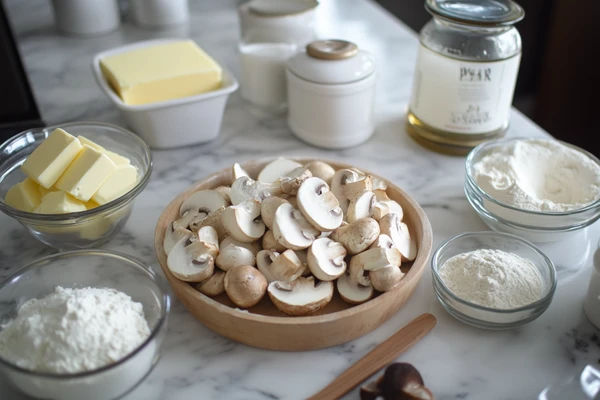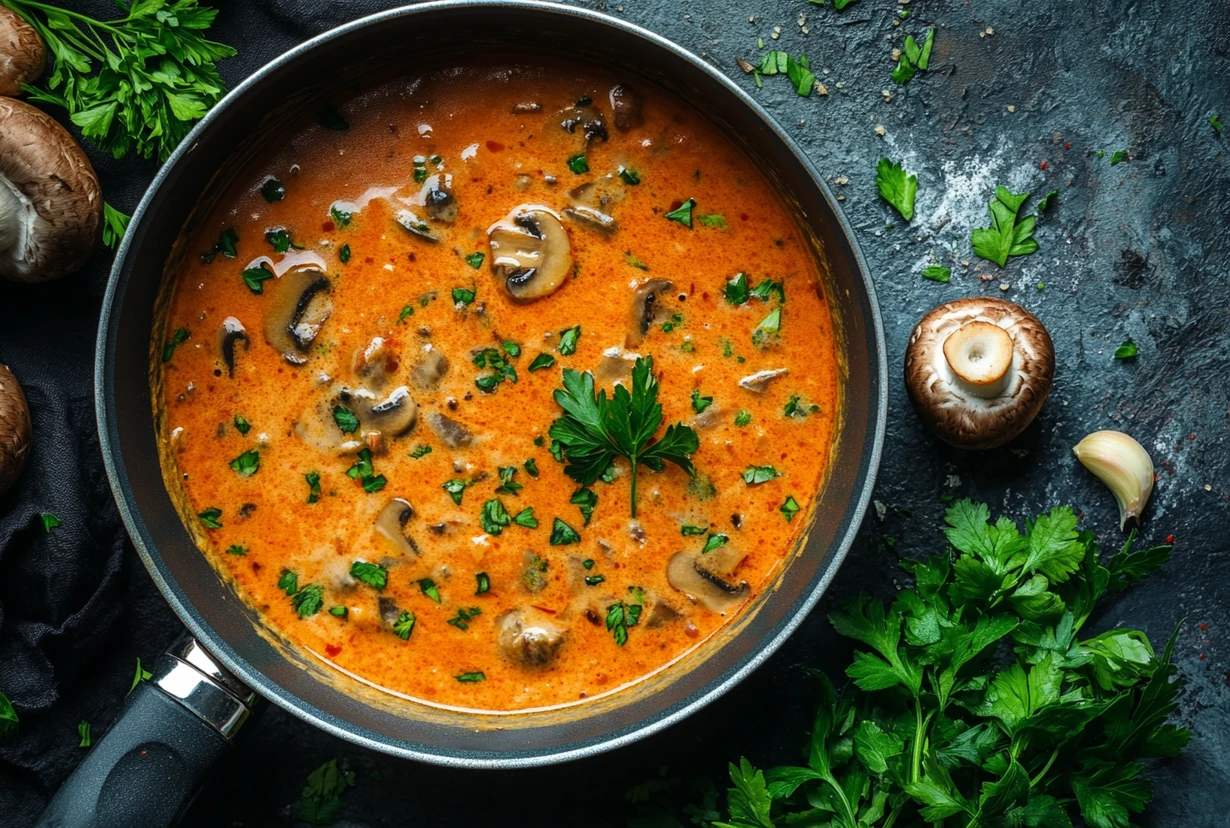Cooking the perfect mushroom sauce can elevate any dish, but achieving the right texture is often a challenge. If your mushroom sauce turns out too watery, don’t worry—you’re not alone! This article will help you identify common mistakes and show you how to fix them with ease.
Introduction
Mushroom sauce is a beloved addition to many dishes, from pasta and steaks to vegetables and casseroles. Its creamy texture and earthy flavor make it a favorite for home cooks and chefs alike. However, it’s not uncommon to encounter the issue of a watery sauce, which can leave your dish lacking the desired richness and consistency. If you’ve been wondering, why is my mushroom sauce watery, you’re in the right place.
The good news is that this problem has simple solutions. Understanding the reasons behind a runny sauce will help you avoid it in the future. Whether it’s about adjusting your cooking techniques or tweaking ingredient proportions, mastering these tips will ensure your mushroom sauce is always perfectly thick and flavorful. Let’s dive in!
Common Reasons Your Mushroom Sauce Turns Watery
If you’ve struggled with a mushroom sauce that doesn’t thicken the way you want, understanding the root causes is key. Here are the most common reasons your sauce might be watery:
1. Overcooking Mushrooms
Mushrooms naturally contain a lot of water, and when overcooked, they release even more liquid into your sauce. Sautéing them properly—on medium-high heat until they’re golden brown—can help control how much water they contribute to the dish.
2. Adding Too Much Liquid
Whether it’s broth, cream, or water, adding too much liquid is a surefire way to thin your sauce. Always start with less liquid than you think you need, as you can always add more later to adjust the consistency.
3. Skipping a Thickener
A thickening agent like flour, cornstarch, or heavy cream plays a crucial role in achieving a velvety texture. If you skip this step, your sauce is likely to remain runny no matter how long you cook it.
4. Using Low-Heat Cooking
Cooking sauce over low heat might seem safe, but it can prevent proper evaporation. Higher heat is often needed to reduce excess liquid and thicken the sauce naturally. Just be sure to stir frequently to avoid burning.
5. Incorrect Ratios of Ingredients
An imbalance between solid ingredients like mushrooms and liquid components can affect the sauce’s consistency. Following a well-tested recipe or carefully measuring your ingredients can help prevent this issue.

By identifying these common culprits, you’re already on your way to perfecting your mushroom sauce. Next, we’ll explore easy fixes for when your sauce turns out too watery.
How to Fix Watery Mushroom Sauce
If your mushroom sauce is already watery, don’t worry—there are several easy ways to save it. Here are some effective methods to thicken your sauce and bring it to the perfect consistency:
1. Simmer the Sauce Longer
One of the simplest ways to fix a watery sauce is to let it simmer over medium heat. This allows excess liquid to evaporate, naturally thickening the sauce. Stir occasionally to prevent sticking, and be patient—sometimes, a few extra minutes can make all the difference.
2. Add a Thickening Agent
Thickening agents like flour, cornstarch, or arrowroot powder are lifesavers when dealing with runny sauces. Mix a small amount of your chosen thickener with cold water to create a slurry, then slowly whisk it into the sauce. Cook for a few minutes to let the thickener work its magic.
3. Sauté Mushrooms Separately
If you’re starting fresh, try cooking the mushrooms separately before adding them to your sauce. This step ensures the mushrooms release their water in the pan, not in your sauce. Once browned and slightly crisp, add them to your recipe.
4. Incorporate Cream or Dairy
Adding heavy cream, sour cream, or even cream cheese can help thicken your sauce while also enhancing its richness. Start with small amounts and adjust to your desired consistency. For best results, stir in the cream at the end of cooking to avoid curdling.
5. Avoid Adding Extra Water
Sometimes, the problem lies in adding unnecessary liquid, like washing the pan with water and pouring it into the sauce. Be mindful of your liquid additions and rely on the natural juices from the mushrooms or a small amount of stock.
6. Use a Blender
For a quick fix, blend a portion of your sauce. This creates a thicker texture by incorporating the solid ingredients into the liquid. Use an immersion blender directly in the pan or transfer some sauce to a countertop blender, then mix it back into the pan.
By following these methods, you can easily save a watery mushroom sauce and transform it into a creamy, delectable topping for your favorite dishes.
The Science Behind Mushroom Sauce Consistency
Understanding the science behind why your mushroom sauce turns watery can help you avoid this issue altogether. Let’s explore the main factors that affect its texture:
| Factor | Explanation | How to Address It |
|---|---|---|
| Mushrooms’ High Water Content | Mushrooms are about 80-90% water. When cooked, they release this water, diluting the sauce. | Sauté mushrooms separately to reduce their water content before adding to the sauce. |
| Heat and Evaporation | Low heat slows evaporation, leaving excess liquid in the sauce. | Use medium to high heat to encourage evaporation and thicken the sauce. |
| Lack of Fat | Fats like butter or cream create a creamy consistency and bind liquids. | Add a fat source like heavy cream, butter, or a non-dairy alternative. |
| Imbalanced Ratios | Too much liquid compared to solids dilutes the sauce, making it watery. | Follow recipes carefully to balance ingredients. |
Mushrooms’ High Water Content
Mushrooms are spongy and absorb water easily during washing or cooking. As they cook, they release this moisture, which can overwhelm the consistency of the sauce. Sautéing mushrooms separately helps reduce this issue by allowing their water to evaporate first.
How Heat Affects Sauce Texture
Cooking at low heat may feel safe, but it prevents effective evaporation. Medium or high heat is essential for reducing liquid and achieving the right thickness. Stir regularly to prevent burning while maintaining steady evaporation.
Importance of Fat for Creaminess
Fat not only adds flavor but also acts as a binding agent. Without enough fat, your sauce may separate or become thin. Incorporating butter, heavy cream, or a suitable non-dairy option helps emulsify the sauce and gives it a luxurious texture.
By understanding these scientific principles, you’ll have better control over your mushroom sauce’s texture, ensuring it turns out thick and flavorful every time.
Pro Tips for Perfect Mushroom Sauce Every Time
Consistency is key when making mushroom sauce, and a few expert tips can help you achieve it effortlessly. Keep these strategies in mind for a sauce that’s always creamy and never watery:
1. Balance Ingredients for the Best Results
The ratio of mushrooms, liquid, and thickeners is crucial. A well-balanced recipe ensures that the flavors meld together while the sauce maintains its structure. Use a kitchen scale or measuring cups for precision when adding liquids and solids.
2. Add Liquid Gradually
Rather than pouring all your broth or cream at once, add it in small increments. This approach allows you to monitor the sauce’s consistency and stop before it becomes too thin. It’s easier to add more liquid than to remove it.
3. Taste and Adjust Seasoning
Salt, pepper, and herbs not only enhance flavor but can also subtly influence texture. For example, too much salt can draw moisture from mushrooms, making the sauce runnier. Add seasoning gradually and adjust as the sauce thickens.
4. Use High-Quality Mushrooms
Fresh, firm mushrooms retain less water and offer a better texture than older, soggy ones. Choose varieties like cremini or shiitake for their natural richness and lower water content compared to standard white mushrooms.
5. Invest in the Right Equipment
A heavy-bottomed pan helps distribute heat evenly, ensuring your sauce cooks uniformly without hot spots. Additionally, tools like immersion blenders or silicone spatulas make it easier to achieve the perfect texture.
6. Cool the Sauce Properly
When storing leftover sauce, allow it to cool completely before refrigerating. This prevents condensation from forming, which can water down the sauce when reheated.
By applying these pro tips, you’ll not only fix watery mushroom sauce but also consistently create a rich, flavorful sauce that’s perfect for any dish.
FAQs About Mushroom Sauce
If you still have questions about getting the perfect mushroom sauce, here are answers to some of the most common concerns:
1. How Do I Thicken Mushroom Sauce Without Flour?
If you want to avoid flour, you can use alternatives like cornstarch, arrowroot powder, or tapioca starch. Another option is to use heavy cream, sour cream, or even puréed vegetables like cauliflower to thicken the sauce naturally.
2. Can I Use Non-Dairy Cream?
Yes, non-dairy options like coconut cream, cashew cream, or almond milk can work as substitutes for heavy cream. Coconut cream is especially effective because of its richness, but it may slightly alter the flavor of the sauce.
3. What If My Sauce Becomes Too Thick?
If your sauce thickens more than desired, you can easily fix it by adding a splash of broth, milk, or even water. Add the liquid gradually and stir well until the sauce reaches your preferred consistency.
4. How Do I Prevent Watery Sauce When Reheating?
Reheating can sometimes thin out a previously thickened sauce. To avoid this, reheat the sauce gently over low heat, stirring constantly. If it becomes too watery, add a bit of thickening agent like cornstarch or cream to restore its consistency.
5. Can I Freeze Mushroom Sauce?
Yes, mushroom sauce can be frozen. Store it in an airtight container or freezer bag for up to three months. When reheating, thaw it in the refrigerator first and warm it gently to avoid separation or thinning.
6. Why Does My Sauce Separate After Cooking?
Sauce separation often occurs when the fat and liquids don’t emulsify properly. This can be due to insufficient mixing or adding cream to an overly hot sauce. To fix this, whisk the sauce vigorously or blend it slightly with an immersion blender to re-emulsify.
Conclusion: Mastering the Perfect Mushroom Sauce
A rich, creamy mushroom sauce can elevate any dish, but achieving the perfect consistency requires a little know-how. If you’ve ever asked yourself, why is my mushroom sauce watery, now you know the common causes and easy fixes to ensure it turns out perfectly every time.
By understanding the role of mushrooms’ natural water content, the importance of cooking techniques, and the balance of ingredients, you can avoid a watery sauce altogether. Whether you’re simmering longer, using thickening agents, or balancing your liquids and solids, small adjustments make a big difference.
With the tips and strategies shared in this guide, you’ll not only save your current sauce but also gain the confidence to create consistently amazing mushroom sauces in the future. So grab your ingredients, try out these tips, and enjoy the creamy, flavorful results!

